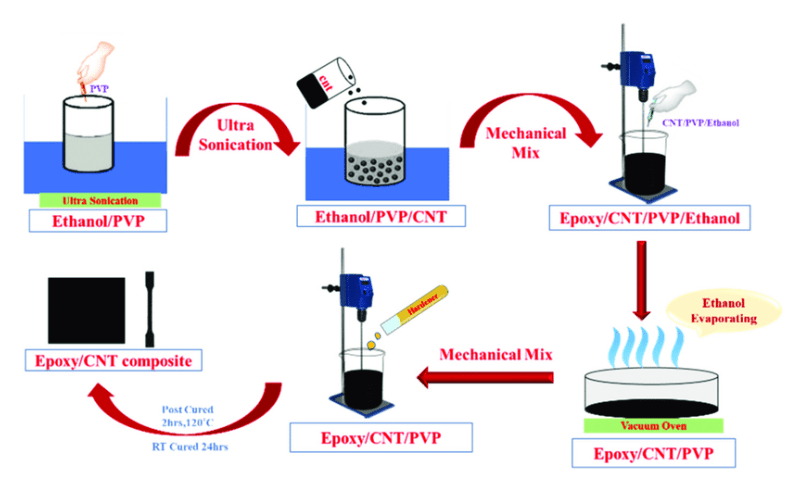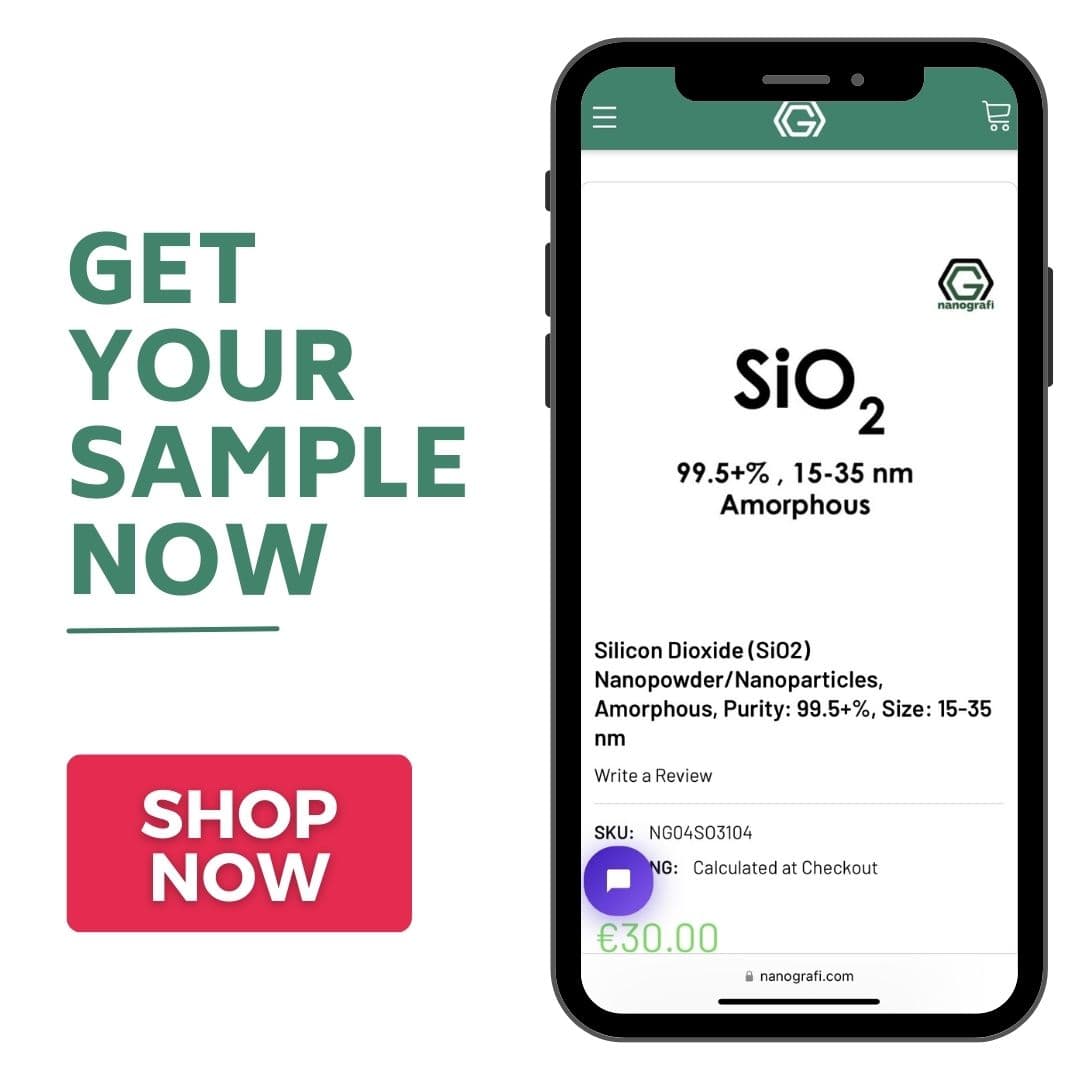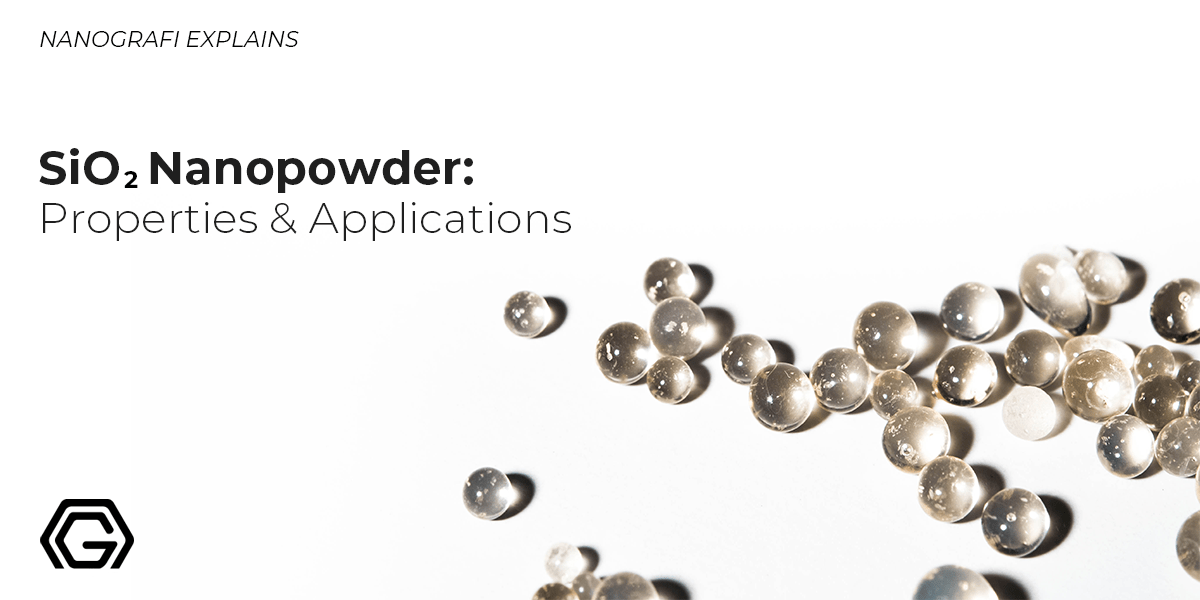Nanostructured Epoxy Adhesives
Nanostructured epoxy adhesives represent a significant advancement in adhesive technology, primarily characterized by the integration of nanoscale materials, such as nanoparticles or nanofillers, into epoxy formulations.
This nanostructuring enhances the adhesives' bonding strength, durability, and flexibility, making them highly effective in creating stronger and more durable bonds compared to traditional epoxy adhesives. Discover the nanomaterials needed to create these effective adhesives now at Nanografi.
Introduction
Nanostructured epoxy adhesives exhibit remarkable properties such as improved mechanical strength, enhanced thermal and chemical resistance, and reduced curing times. Their high surface area-to-volume ratio due to the inclusion of nanoscale materials leads to better adhesion, especially on uneven or rough surfaces. In addition, In industrial and everyday applications, nanostructured epoxy adhesives find extensive use in sectors such as aerospace, automotive manufacturing, electronics, and construction.
What are Epoxy Adhesives?
Epoxy adhesives, also known as epoxy resin or epoxy glue, are powerful and versatile bonding agents composed of epoxy resins and hardeners. These adhesives are highly regarded for their remarkable bonding strength and exceptional durability. Epoxy adhesives function through a chemical reaction between the epoxy resin and hardener, resulting in a hardened and robust bond. They can effectively adhere to a wide array of materials, including metals, plastics, ceramics, wood, and glass, often creating bonds stronger than the materials themselves.
Furthermore, epoxy adhesives offer remarkable resistance to moisture, chemicals, and extreme temperatures, making them suitable for both indoor and outdoor applications. Their ability to fill gaps and adapt to irregular surfaces enhances their practicality, while their availability in clear or colored forms accommodates various aesthetic requirements. Epoxy adhesives find applications in numerous industries, such as construction, aerospace, electronics, and woodworking, and are indispensable in DIY projects and home repairs. Safety precautions, including proper ventilation and protective gear, should be observed when working with epoxy adhesives to ensure safe and effective use.
Understanding Nanostructuring in Adhesives
Nanostructuring in adhesives refers to the deliberate manipulation and incorporation of nanoscale materials, such as nanoparticles or nanofillers, into adhesive formulations to enhance their properties and performance. This process involves altering the adhesive's microstructure at the nanoscale level, typically with the aim of improving adhesive strength, durability, flexibility, and other characteristics. Here's an overview of the key aspects of nanostructuring in adhesives:
Nanomaterials Integration: Nanostructuring involves the addition of nanoscale materials, which can include nanoparticles of various types (e.g., silica, carbon nanotubes, graphene, clay nanoparticles). These nanomaterials are dispersed within the adhesive matrix to create a more complex microstructure.
Improved Bonding Strength: One of the primary objectives of nanostructuring adhesives is to enhance their bonding strength. The addition of nanoparticles can create a more intimate contact between the adhesive and the substrate, leading to stronger adhesive bonds.
Increased Surface Area: Nanoscale materials have a high surface area-to-volume ratio, which can lead to better adhesion due to increased contact points with the substrate. This is particularly advantageous when bonding materials with uneven or rough surfaces.
Enhanced Mechanical Properties: Nanostructuring can improve the mechanical properties of adhesives, such as toughness, elasticity, and resistance to deformation. This is essential in applications where adhesives need to withstand mechanical stress.
Improved Thermal and Chemical Resistance: Nanomaterials can enhance an adhesive's resistance to temperature extremes, chemicals, and environmental factors. This makes nanostructured adhesives suitable for demanding applications, including those in extreme environments.
Reduced Curing Time: Some nanostructured adhesives exhibit faster curing times due to the catalytic effects of certain nanomaterials. This can be advantageous for applications that require rapid bonding.
Tuned Adhesive Properties: Nanostructuring allows for tailoring adhesive properties to meet specific application requirements. By adjusting the type and concentration of nanomaterials, adhesives can be customized for various uses.
Nanocomposite Adhesives: In some cases, nanostructuring involves creating nanocomposite adhesives, where the nanomaterials are evenly distributed throughout the adhesive matrix. These nanocomposites can exhibit superior properties compared to traditional adhesives.
To get information about silver conductive paste, which can be used as nanocomposite adhesive, you can read our blog post.
Challenges and Safety Considerations: While nanostructured adhesives offer numerous advantages, there are challenges to consider, including the proper dispersion of nanomaterials and potential health and safety concerns related to the handling of nanoparticles.
Nanostructuring in adhesives is an area of ongoing research and development, as it holds the potential to revolutionize adhesive technology across various industries, including aerospace, electronics, construction, and healthcare. The ability to fine-tune adhesive properties at the nanoscale level opens up new possibilities for creating high-performance adhesives that can meet the increasingly demanding requirements of modern applications.
Advantages of Nanostructured Epoxy Adhesives
Nanostructured epoxy adhesives present a multitude of advantages, making them a preferred choice for a wide range of applications. These adhesives, enriched with nanomaterials, exhibit significantly enhanced bonding strength, unmatched toughness, and remarkable durability. Their ability to cure rapidly is invaluable in industries requiring efficient production processes. Moreover, nanostructuring reinforces their resistance to harsh chemicals and high temperatures, extending their utility to demanding environments. Nanostructured epoxy adhesives also excel in adhering to diverse surfaces and can be precisely tailored to meet specific application needs, from reducing shrinkage and stress to enhancing electrical and thermal conductivity. This multifunctionality and the promise of ongoing technological advancements in nanotechnology ensure that these adhesives will continue to play a vital role in meeting the evolving demands of modern industry. However, their safe handling and proper dispersion of nanomaterials must be carefully managed to realize these benefits fully.
Methods of Incorporating Nanostructures into Epoxy
Incorporating nanostructures into epoxy is a process vital to the development of nanostructured epoxy materials with enhanced properties. Several methods are employed to achieve uniform dispersion and integration of nanomaterials within the epoxy matrix. These techniques range from manual mixing and ultrasonication to mechanical stirring, solvent-assisted mixing, and in-situ polymerization. Additionally, methods like surfactant-assisted mixing and surface modification play a crucial role in enhancing the compatibility and dispersibility of nanomaterials within the epoxy. The choice of method depends on factors such as the type of nanomaterial used, the desired properties of the resulting nanostructured epoxy, and the scale of production. Regardless of the method chosen, achieving homogeneous dispersion is essential to fully exploit the potential benefits of nanostructured epoxy materials. Furthermore, safety considerations must be paramount when working with nanomaterials to ensure both the quality of the final product and the well-being of those involved in the process.

Figure 1. Preparation schematic of the Epoxy/CNT nanocomposites.
Performance Comparison: Nanostructured vs. Traditional Epoxy Adhesives
Nanostructured epoxy adhesives outshine their traditional epoxy counterparts in various performance aspects. They offer substantially stronger bonding strength, exceptional durability, and higher toughness, making them the preferred choice for applications where robust and long-lasting bonds are essential. Their ability to cure more rapidly can expedite production processes, although traditional epoxy adhesives still have a place in applications with longer curing time allowances. Nanostructured epoxy adhesives also excel in challenging environments, displaying superior resistance to chemicals and high temperatures. Their capacity to adhere to diverse surfaces, including irregular and rough ones, is advantageous.
Moreover, nanostructured epoxies allow for tailored properties, improved electrical and thermal conductivity, and multifunctionality, further expanding their applicability. While traditional epoxy adhesives remain reliable options, particularly in less demanding applications, the remarkable performance enhancements offered by nanostructured epoxies have elevated them to a prominent position in industries where strong and versatile adhesive solutions are indispensable. However, the integration of nanomaterials necessitates diligent attention to safety considerations throughout the production process.
Industrial and Everyday Applications of Epoxy Adhesives
Nanostructured epoxy adhesives are crucial in industrial and everyday applications due to their exceptional performance characteristics.
-In the industrial sector, they are used in:
- Aerospace: Bonding lightweight composite materials,
- Automotive manufacturing: Assembling components.
- Electronics industry: Ensuring reliable encapsulation of electronic parts.
-In construction and marine applications, they provide:
- Robust structural bonding.
- Resilience to environmental stresses.
-In the energy sector, they are utilized in renewable energy technologies.
In everyday life, these adhesives are used for:
- DIY and home repairs: Fixing household items and enhancing furniture durability.
- Crafts and art: Offering clarity and versatility for jewelry making and art projects.
- Woodworking: Appreciated for their gap-filling capabilities.
They are also integral in:
- Constructing sports equipment.
- Reinforcing the durability of footwear.
- The widespread adoption of nanostructured epoxy adhesives highlights their ability to meet the demands of various applications, combining strength, resilience, and adaptability for both industrial and personal projects.
For more information about SiO2, visit our blog page.
Challenges and Opportunities in Nanostructured Epoxy Adhesives
Nanostructured epoxy adhesives offer a host of advantages, from significantly improved bonding strength and durability to tailored properties and multifunctionality. However, they come with challenges related to dispersion, safety, cost, and regulatory compliance. Despite these hurdles, the opportunities in the field are abundant. The potential for innovative solutions in multiple industries, driven by advancements in nanotechnology, is a compelling opportunity. Cross-industry collaboration and the environmental benefits, particularly in terms of weight reduction and energy efficiency, make nanostructured epoxy adhesives a dynamic and evolving area of research and application. Addressing safety, cost, and regulatory concerns is essential to unlock their full potential, but the promise of enhanced performance and customized properties positions these adhesives as key players in various industries, from aerospace and automotive to electronics and healthcare.
The Future of Nano-Adhesives in Industry
The future of nano-adhesives in industry holds great promise, with advancements in materials and technology poised to revolutionize various sectors. These adhesives are set to provide enhanced performance, offering stronger and more durable bonds, tailored properties, and multifunctionality. Innovations in nanomaterials will expand the possibilities, enabling the development of novel adhesives that can address specific industry challenges, such as extreme environmental conditions.
Additionally, their potential to reduce weight and energy consumption will contribute to more environmentally sustainable practices, particularly in sectors like transportation and construction. Nano-adhesives will also play a vital role in healthcare and biotechnology, supporting the creation of innovative medical devices and drug delivery systems. Collaboration across industries, driven by increased awareness of the benefits of nano-adhesives, will foster innovation and accelerate the adoption of these transformative bonding solutions. As regulatory frameworks evolve to address safety and environmental concerns, the future of nano-adhesives appears to be dynamic and promising, offering a new era of possibilities in industrial applications.

Conclusion
In conclusion, nanostructured epoxy adhesives offer remarkable opportunities and advancements in various industries. These adhesives, with their potential for enhanced performance, customization, and multifunctionality, are poised to reshape the way we approach bonding and assembly. As nanotechnology continues to evolve, we can anticipate more innovative solutions, environmental benefits, and cross-industry collaboration, making nano-adhesives a crucial driver of progress and sustainability in the industrial landscape.
As Nanografi, we continue to bring you high quality nanomaterials from which you can obtain epoxy adhesives with our advanced material materials.
References
Ahmadi, Z. (2019). Nanostructured epoxy adhesives: A review. Progress in Organic Coatings, 135, 449–453. https://doi.org/10.1016/J.PORGCOAT.2019.06.028
Analyzed: Silver Conductive Adhesive Paste - Nanografi Nano Technology. (n.d.). Retrieved January 16, 2024, from https://nanografi.com/blog/analyzed-silver-conductive-adhesive-paste/
Jojibabu, P., Zhang, Y. X., & Prusty, B. G. (2020). A review of research advances in epoxy-based nanocomposites as adhesive materials. International Journal of Adhesion and Adhesives, 96, 102454. https://doi.org/10.1016/J.IJADHADH.2019.102454
Kenig, S., Dodiuk, H., Otorgust, G., & Gomid, S. (2020). Nanocomposite Polymer Adhesives. Progress in Adhesion and Adhesives, 93–167. https://doi.org/10.1002/9781119749882.CH5
Nanocomposite Polymer Adhesives - Progress in Adhesion and Adhesives - Wiley Online Library. (n.d.). Retrieved January 16, 2024, from https://onlinelibrary.wiley.com/doi/10.1002/9781119749882.ch5
Preparation schematic of the Epoxy/CNT nanocomposites. | Download Scientific Diagram. (n.d.). Retrieved January 16, 2024, from https://www.researchgate.net/figure/Preparation-schematic-of-the-Epoxy-CNT-nanocomposites_fig2_351411925
SiO2 Nano powder: Properties & Applications - Nanografi Nano Technology. (n.d.). Retrieved January 16, 2024, from https://nanografi.com/blog/sio2-nano-powder-properties-applications/
Recent Posts
-
Advanced Materials for Unmanned Aerial Vehicle (UAV) Protection Against Laser
Consider a UAV on a critical mission, rendered inoperative by a sudden laser attack. With the increa …26th Jul 2024 -
Simulation and Modeling of Material Properties
Our world is composed of a dazzling array of materials, each with its own unique properties that dic …19th Jul 2024 -
Advanced Coatings for Superior Corrosion and Wear Resistance
Corrosion and wear pose significant challenges across various industries, leading to substantial eco …12th Jul 2024






